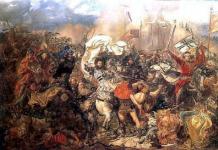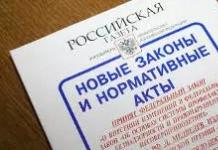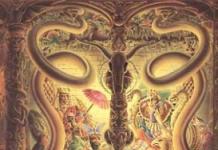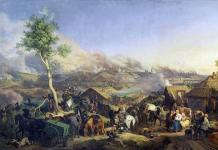→
Reformation is a popular movement of the 16th century directed against the Catholic Church and led to the emergence of Protestantism. The leaders of this movement were Luther in Germany and Calvin in Switzerland. This movement had a much stronger influence on European society than the Renaissance. The humanism of the previous era played a dual role in the emergence of Protestantism: on the one hand, it undermined the prestige of the church and cleared the way for the Reformation, exalting secular learning and art. On the other hand, the Reformation was a revolt not only against the Catholic Church, but also against humanism, because Its leaders were distinguished by fanatical religiosity in the struggle for the concept of a “new church.”
The Reformation was caused by the collapse of the feudal mode of production and the emergence of new capitalist relations. The fact is that the movement for the transformation of the Catholic Church was supported by burghers, small traders, artisans, and peasants, who were characterized by religious fanaticism and alien to the spirit of moral freedom of the Renaissance figures. In fact, the Reformation demanded a transformation of the Catholic Church that would meet the interests not of the feudal authorities, but of the bourgeoisie.
The impetus for the mass movement for the Reformation was the act of the German monk Martin Luther, who nailed the famous 95 theses , who condemned the sale of indulgences, which had become common in the Catholic Church. It was possible to “atone” for the most terrible crime by purchasing absolution for money - a piece of paper - a letter, which was sold by papal envoys in public places.
The sale of indulgences became such an important source of income for the Catholic Church that it forced people to buy these papers for sins not yet committed. This vicious practice caused indignation among believers - the greed of the clergy became too obvious.
It is interesting that the parishioners did not condemn the church’s right to condemn and pardon sinners, but rather the dirty monetary and commercial form of absolution. M. Luther went further than this quite obvious and understandable moral crime: he believed that through this kind of commercial practice a person is freed from the need for internal repentance. And this violated the well-known evangelical call: “Repent, for the kingdom of God is at hand!” It turned out that the Catholic Church actually rejected the main requirement of Christianity and the condition of human salvation - a person's inner repentance.
The salvation of a person, according to M. Luther, is in a person’s personal faith. Man is so sinful, he claims, that no amount of religious merit can bring him closer to salvation. You can only be saved by faith in the atoning sacrifice of Jesus Christ. “It is impossible to prescribe that faith should be combined with good deeds, for true faith cannot, in its essence, fail to end up in a righteous life” - he repeated this thesis more than once. At the same time, faith in the atoning sacrifice of Christ is not a person’s personal merit, but acts as a manifestation of divine mercy - chosenness, i.e. Only those whom he has chosen for salvation truly believe, asserted M. Luther.
In connection with this understanding of faith and salvation, M. Luther believed that it was necessary to eliminate monasticism, abolish fasts, turn monasteries into schools, abolish the practice of pilgrimage to holy places, etc. There is no difference between priests and laity. Everyone has the right to communicate with God, and not just the clergy, as it was interpreted in the dogmatics of Catholicism. Luther goes further and rejects the entire church hierarchy headed by the “demonic prince” - the pope. He calls the papacy an “anti-Christ institution” leading to temptation and sin. The papacy stole God from man and engaged in the speculative sale of his grace. In essence, Luther demanded a return to the moral principles of early Christianity and advocated pure and sincere faith in God.
The ideological source of the Reformation was Bible . Jacques Calvin, Ulrich Zwingli and Martin Luther - the main champions of the Reformation of the Catholic Church argued that the source of truth in religion is not the sacred oral tradition, but the Holy Scripture, primarily the Gospel. They insisted on the indisputable authority of Scripture, on the right of every believer to have their own understanding of its content. The fact is that before the Reformation, the Bible was published only in Latin, which was a “dead” language and was inaccessible to understanding by the broad masses of believers. Latin was studied and known only by clergy. They, and in their person the entire church, acted as a mediator between the Revelation of God, set out in the Bible, and people. And the church interpreted the Bible according to sacred tradition. As a result of this state of affairs, the pope's decision in matters of faith became the final authority. M. Luther and his supporters, rejecting sacred tradition (as opposed to Orthodoxy and Catholicism), proclaimed the Bible as the only source of doctrine. Not papal orders and decrees, not oral tradition, but only the canonical books of the Old and New Testaments ( Holy letter ) can be a source of truth. Luther was the first to translate the Bible into German and proclaimed the right of every believer to study and interpret it. Thus, he deprived the Catholic Church of the right to create in the name of Holy Scripture (after all, all people are equally affected by original sin). On such foundations a new direction of Christianity emerged - Protestantism.
Ethics of Protestantism was distinguished by simplicity in relations between people, by preaching the limitation of one's own needs, by a negative attitude towards luxury, wastefulness, and idleness. This met the interests of the petty bourgeoisie, the entrepreneurial spirit inherent in capitalism, and the formation of high self-esteem based on the fact that they are the bearers of the divine historical mission. The education and promotion of such moral qualities played a certain role in the fact that it was the Puritans, forced as a result of religious and political persecution to migrate from Europe to North America at the beginning of the 17th century, who became the leaders of Western civilization.
By abandoning the Catholic-type church organization, Protestants opened the way to bourgeois-democratic freedoms, development bourgeois individualism. The exuberant Catholic religious cult was simplified and lavish. M. Luther abolished monasticism, he himself cast off his monastic rank and married a nun, which was a violation of the monastic vow of celibacy ( celibacy). The liturgy, which was usually conducted in Latin, was reduced to a sermon. The veneration of icons and relics was also abolished; of the seven religious sacraments, Protestants began to observe only baptism and communion. Protestants do not recognize saints, angels, do not honor the cult of the Mother of God, and deny the idea of purgatory. Religious worship became simpler and cheaper. Protestant clergy are elected by the laity. It was all close primarynew Christianity.
The concept of a “new church” emerged, and Catholicism was reformed. The core of the Protestant worldview was the position: “Everything is from God.” This saved a person from useless worries about the progress of worldly affairs. Man can only hope in God and believe in his salvation.
As emphasized, the connection between the Reformation and the Renaissance is undeniable, but it is ambiguous. Their union was temporary. The alliance with young humanists was caused by the need for the latter, for the purposes of national interests, to stand under religious banners. Already in 1521, an ideological gap occurred between them. Luther's teachings in the “universal holy order of believers” had a dangerous effect on the minds - after all, it allowed the clergy into the world of people as teachers and preachers of the Gospel, and created guarantees for the preservation of existing orders.
The bourgeois character of Protestantism was more clearly manifested in the teaching J. Calvin - ideologist of the Reformation in Switzerland. He proclaimed the main values self-restraint, enrichment, asceticism, put forward two ideas: about divine non-interference in the laws of the world (alienation of God from the world) and that people are supposedly predestined even before birth - some to salvation and bliss, others to death and eternal torment. But this divine predestination is hidden from people, so every believer must behave as if he were predestined for salvation. No one knows, Calvin teaches, what awaits him, but every person should think that he is God’s chosen one. And, straining all his strength, prove with his life that he is worthy of salvation.
In everyday life, in practical life, this asceticism acquired the character of bourgeois frugality and led to a reduction in religious holidays and an increase in working days. Conscientious work and obedience, according to Calvinists, are a duty of man, ordained by God. This attitude of radical Protestantism contributed to its break with Renaissance humanism.
It is interesting that J. Calvin himself, preaching modesty, diligence, constant hard work and condemning idle pastime, soon acquired such influence in Geneva that the noisy, cheerful life of this prosperous city became quiet, replaced by seriousness and strict religiosity. Calvin developed a system of coercion and punishment to force the citizens of the city to pray and work. He imposed bans on various amusements and entertainment, and free time. It even went so far as to ban artistic creativity, the practice of literature and art, and in small matters to the regulation of hairstyles, clothing, foods, etc. According to the definition of the famous culturologist Max Weber (1864-1920), honest hard work in Protestantism is relegated to the rank of a religious feat and becomes a kind of "worldly asceticism".
The teachings of M. Luther and J. Calvin contributed to the emergence of a new morality, which was called Puritan by the name of one of the Protestant sects. This name has become common to all movements and sects - Baptists, Presbyterians, Calvinists, etc. Ethics of Puritanism stemmed from a religious worldview and lifestyle that recommended ascetic strictness of morals, hard work, a high sense of duty, frugality, and petty piety. The will of God was considered the source of moral principles and norms.
from lat. reformatio - transformation, correction) - broad, complex in the social composition of the participants, socio-political. and ideological. movement that took the form of a struggle against Catholicism. church and was based on anti-feud. character; covered in the 16th century. most Western countries and Center. Europe. Originally the term "R." used as a synonym for any transformation or improvement. So, in the 14th-15th centuries. talked about R. monasteries, mountains. rights; with the beginning of the conciliar movement - about the need for R. Catholic. churches "in head and members" (reformatio in capite et membris); certain works that demanded the state. transformations were also called. R. (for example, "R. Frederick III", "Reformation of Emperor Sigismund"). In the 16th-17th centuries. R. called the church. transformations in both Catholic and Protestant spirit. Only from the end of the 17th-18th centuries. The term is assigned the meaning of religion. transformation in the Protestant spirit. L. Ranke (L. Ranke, Die deutsche Geschichte im Zeitalter der Reformation, Lpz., 1894) identified the “era of R.”, defining it 1517-55 and delimiting it from the subsequent “era of counter-reformation”. Chronological framework of the "era of R." are defined differently (sometimes as 16th - mid-17th centuries). In the bourgeoisie literature of the 50-60s. 20th century The concept of the “Second Reformation” appeared (in particular, for attempts from the 2nd half of the 16th century to spread Calvinism more widely in a number of principalities of Lutheran Germany). Understanding R. as a broad society. movement associated with deep processes occurring in the socio-economic. life Zap. Europe 16th century, comes from Op. Marx and Engels and accepted in Marxist history. lit-re. The most common, deep-seated reasons that caused R. are associated with the disintegration of feudal rule. production method in Western countries Europe, with the emergence in the depths of feudalism of new, capitalist. relations and new classes, with the aggravation in these conditions of social contradictions and anti-feud. the struggle of the region acquired a new character in these conditions. R. represented the first blow to feudalism. Due to religion. character of the Middle Ages. ideology, it turned out to be directed not yet directly against the feudal lords. state, political feudal superstructures about-va, but against his religions. superstructures - Catholic. church, which was an integral part of the feud. system and gave religion. sanction to the existing feud. I'm building. “In order to be able to attack existing social relations, it was necessary to tear off the halo of sanctity from them” (F. Engels, The Peasant War in Germany, see K. Marx and F. Engels, Works, 2nd ed., vol. 7, p. 361). Already humanistic. the Renaissance movement with its rationalism. criticism of the Middle Ages. worldview and affirmation of the principles of the bourgeoisie. individualism dealt a significant blow to the Middle Ages. Catholic worldview and in many ways ideologically prepared the reformation. movement. Of great importance was the appeal of humanists to the sources of the original. Christianity, their application of the rules of history. criticism of the texts of St. scriptures, their direct and rational interpretation of these texts, etc. Some figures of the Renaissance (especially Erasmus of Rotterdam) had a humanistic. ideas were combined with internal ideas. church reforms and restoration of "evangelical purity" of the original. Christianity, the liberation of the church from the formalism of external ritualism. However, humanistic The movement, due to the utopianism, abstractness, compromise of its program, and isolation from the urgent demands of the masses, could not become the banner of the mass social movements of the era. The ideas of R. became such a banner. An equally important source of R.’s ideas were the Middle Ages. heretical teachings (see Heresies), already long before the 16th century. containing criticism of Catholic churches. In these teachings, especially in those that developed in the conditions of acute social clashes of the 14th-15th centuries, provisions were formulated that anticipated many others. ideas of R. 16th century The speeches of J. Wycliffe and the Lollards in England, Jan Hus, and then the Chashniki and Taborites in the Czech Republic (see Hussite revolutionary movement) are often called early reformations. movements. However, these movements as a whole did not go beyond the Middle Ages. heresies; they have not yet received the social common European nature inherent in R. values (although they have crossed the boundaries of local limitation). In the 16th century, under new conditions, the movement against the Catholic. churches acquired a pan-European meaning and a new quality, turning out to be - in its radical manifestations - directed against the very foundations of the feud. building. R.'s ideologists clothed their demands in the form of new, but also religious. teachings (behind which, however, a very real, “earthly” content was hidden). R. ideologists came out with the statement that a person does not need the mediation of the church (in its Catholic understanding) to save his (sinful) soul - salvation is not achieved externally. manifestation of religiosity (not “good deeds”), but only internal. the faith of everyone (the principle of “justification by faith”, first clearly formulated by M. Luther). Recognition of this position was tantamount to denying the need for Catholicism. church with its complex church. hierarchy headed by the pope, a special layer of clergy, a cut, according to Catholic teaching. church, one thing can convey to a person some kind of supernatural nature. power ("divine" grace"), allegedly necessary for his salvation; the entire teaching of Catholicism about the "treasury of good deeds", the indulgences associated with it (the trade in which served as the impetus for the beginning of the reform movement in a number of countries), etc., were denied. The reformers proclaimed unity. the source of religious truth is “Holy Scripture,” denying as such “Sacred Tradition” (in the dogmatics of the radical movements of the people of R., the doctrine of “immediate divine revelation” acquired great and sometimes decisive importance.) Appeal to the early Christian church (its sources of doctrine, its organization) played an important role in the Reformation teachings (hence the definition of R. that is sometimes found in literature as a “religious Renaissance”). From the denial of the feudalized Catholic Church it followed: the denial of the church as a large feudal owner (carrying out R. everywhere was accompanied by the secularization of church property, especially the huge land property of the Catholic Church), monasteries and monasticism, church tithes and all other numerous. taxes levied by Catholics. church in favor of Rome. curia and clergy; denial of the magnificent Catholic. cult, etc. Reformation. the movement was very difficult. Various classes and social groups took part in it, investing in criticism of Catholicism. churches had different contents and pursued different goals. Burgher-burgh. the direction found its most clear expression in the teachings of M. Luther, W. Zwingli and especially J. Calvin. The demand for the abolition of the complex church. hierarchy, magnificent Catholic. cult, veneration of icons, saints, abolition of a large number of religions. holidays were understood as a requirement for the creation of a “cheap” bourgeoisie. church, more in line with the interests of the bourgeoisie. frugality. The burgher-bourgeois itself. the direction was not uniform. It had a moderate-burgher wing, which compromised with feudalism and remained mainly on the basis of theology (Luther) and a radical-bourgeois wing. direction. The most consistent expression of the latter was Calvinism, which gave the bourgeoisie an ideological. weapons and org. forms (republicanism) in revolution. the fight against feudalism, gave religion. justification for bourgeois norms. morality (the doctrine of predestination and the “worldly calling” and “secular asceticism”). Nar. the direction of R. expressed the interests of the peasantry and mountains. plebeianism. For people the masses began the struggle against the Catholics. church served as a signal to fight against the very foundations of feudal rule. building. The most radical of the people's ideologists. R., turning to the Gospel and demanding the restoration of the early Christ. equality of members of religions. communities, denying the need for the church. hierarchy and demanding the liquidation of the church. land ownership, drew conclusions about the need to abolish all spiritual and secular authorities, establish social equality and community of property - transform the land (in the first place) into the property of the working people. R. was understood by them in the spirit of the future social and political. a revolution in the interests of the working people, the establishment by the rebel people of the “kingdom of God on earth” as a system of social justice. People's ideas R. played a large role in the anti-feud that unfolded everywhere during this period. people's struggle masses, giving it ideological. justification and creating certain prerequisites for its centralization. The self-sufficiency was especially great. meaning adv. R. where she became ch. expression antifeud. struggle (for example, in Germany - due to the immaturity of the bourgeois elements there). To the currents of the people. R. belonged to Anabaptism (see Anabaptists), which was losing in the conditions of the rise of mass people. movements have their closed sectarian character, the left wing of the Socinians (Arians, Anti-Trinitarians), etc.; the largest ideologist and activist of the people. R. was T. Münzer. In a number of countries reformation. the movement has lost its original. antifeud. character, having been used by the fief. class in its own interests (the so-called royal-prince R., or R. "top") - to strengthen the economic. and political influence of queens. authorities (scand. countries, England) or department. princes (Germany). The implementation of reform “from above” was accompanied by the secularization of the church. lands in favor of secular power; The newly created churches here that broke away from Catholicism were completely subordinated to it. Finally, in some countries (for example, in France) R. was used by part of the feud. nobles in order to fight the queens. absolutism. All this testifies to the extremely complex nature of the reformation. movement and explains the intense struggle that unfolded not only between R.’s supporters and its opponents, but also within the reformation. camps. During R., which covered in the 16th century. Germany, Switzerland, Scand. countries, the Czech Republic, Hungary, Poland, the Netherlands, England, France, there were significant differences. The center and starting point of the reformation. movement came from Germany, a region due to the peculiarities of its socio-economic. and political development began in the 1st quarter. 16th century arena of the first act of the bourgeoisie. revolutions in Europe (see article Germany). Here one of the chapters. antifeud tasks. revolution was the abolition of feudal rule. fragmentation, the establishment of national unity, and in these conditions, opposition to the Catholic. The church, which freely exploited a fragmented country in favor of the papacy and became an object of universal hatred, acquired special significance. Performance 31 Oct. 1517 Luther in the Saxon city of Wittenberg with 95 theses against the trade in papal indulgences served as a signal for the beginning of a wide society. movements. Initially, it united various layers of the opposition: the burghers, the peasant-plebeian masses, the knighthood; Some of the princes also joined R. However, already from 1520-21, a demarcation began. classes and groups that joined R. Nar. R. (its outstanding representatives - T. Münzer, M. Geismair) resulted in a powerful anti-feud. people's speech masses - the Peasant War of 1524-25, which was the culmination of the entire reformation. movements in Germany. Under these conditions, moderate conservative circles are silent. The burghers, whose ideologist was Luther, compromised with the feudal princes. camp; Luther openly opposed the revolutionaries. actions of people wt. This compromise also affected the evolution of religions. Luther's teachings (see Lutheranism). The radical-burgher direction of R. (Karlstadt, Buzer) was unable to occupy a leading place in Germany. Nar. the movement (the war of the Cross, then the Münster Commune of 1534-35, led by the revolutionary Anabaptists) was suppressed. This allowed the Germans. princes to use R. for their own purposes. The princes of Saxony, Mecklenburg, Pomerania, Brandenburg, Hesse, Palatinate, Brunswick, etc., having carried out the Revolution in their lands, appropriated all the churches. wealth. Between the emperor and the princes who remained Catholic, on the one hand, and the princes who joined R., on the other, a long, ruinous struggle for the country began, which strengthened the decentralization of Germany, a struggle that led to the conclusion of the Religious Peace of Augsburg in 1555, and later to the Thirty Years' War 1618-48. Introduction of the queens. R. in Sweden, freed from dates under Gustav I Vasa. domination was a means of strengthening independence. queens power and independence. Vasa dynasty in the country (the largest figures of the Swedish Republic are the brothers O. and L. Petri, its legal registration and legislative consolidation - at the Westerosi Riksdags of 1527 and 1544, at the general Swedish church council of 1529 in Örebro, final approval - in the late 16th - early 17th centuries, after the elimination of attempts to restore Catholicism under King Sigismund III Vasa). R. was also introduced in Finland, which was subordinate to Sweden (the largest figure in Finnish R. was M. Agricola). In Denmark the beginning of the spread of reformation. ideas dates back to the reigns of Christian II (1513-23) and Frederick I (1523-33). Major figures of the dates. R.- H. Tausen, K. Pedersen. In the 30s under the banner of R. the people unfolded. a movement that was intertwined with the struggle within the dominations and class (“Count’s Feud” 1534-36). Christian III, having suppressed the movement, saw off the queens. Lutheran R., using it in his political. purposes (1536 - church diet in Copenhagen, 1537 - publication of the so-called church ordination, which introduced a new church system). Violent the holding of Lutheran R. in Norway (1536) and Iceland (from 1540), subject to Denmark, was used to strengthen the dates there. domination. R. in Switzerland, which developed in close connection with R. and Cross. the war in Germany was an expression of acute class. struggle in Switzerland itself. Economically developed cantons and cities (Zurich, Bern, Basel, Geneva), in which feudal fiefdoms, became the centers of republics here. and communal land. relations and guild craft were disintegrating under the influence of developing capitalist systems. relationships. The backward forest cantons (Schwyz, Uri, Zug, etc.) and the nobility remained in the feudal-Catholic camp. reactions. They resisted the spread of R. and the aspiration of the mountains. cantons to state centralization. R. in Zurich (in which Zwingli's activities took place), Bern, Basel and other cities was carried out in the 20s. 16th century and initially took the form of Zwinglianism. At the same time, the cross-plebeian movement developed, led by the Anabaptists in Crimea. However, the burghers did not support this movement, which was suppressed shortly after the defeat of the Cross. wars in Germany. After the defeat of the troops of the cantons - supporters of R. in the Kappel Wars by the forest cantons and the death of Zwingli (1531), in the situation that began in the middle. 16th century political decline activity, Zwinglian R. lost its original. fighting spirit. In Geneva, after progressive burgher elements (primarily from among the “new citizens” - immigrants from France and other countries) came to power in the city in the 40s. 16th century A new movement of R. - Calvinism - took shape. Soon he went all over Europe. arena, giving the nascent bourgeoisie an ideology that substantiated its claims to politics. domination. Strengthening absolutism, disintegration of feudalism. relations and the emergence of capitalism. way of life led to an exacerbation of social contradictions and created favorable soil for R. in France. Its first preachers were J. Lefebvre d'Etaples and G. Brisonnet (bishop of Mo). In the 20-30s. 16th century Lutheranism and Anabaptism spread among wealthy townspeople and the plebeian masses. Late 30s marked by massive repressions against “heretics”. New rise of reformation. movement, but in the form of Calvinism, dates back to the 40-50s. The originality of the French R. was that Calvinism was ideological here. banner as a social protest of the plebeians and the emerging bourgeoisie against the feudal lords. exploitation and opposition to the reactionary-separatist feud. aristocracy against the growing queens. absolutism; the latter, to strengthen his power in France, used not R., but Catholicism, while at the same time asserting the independence of the French. Catholic churches from the papal throne (royal Gallicanism). The opposition of various layers to absolutism resulted in the so-called. religious wars that ended in the victory of the queens. absolutism. Catholicism remained the official religion in France. In the Habsburg lands (in Austria, the Czech Republic, part of Hungary), where the reformation. The movement in various forms also spread widely (especially since the 60s), it became a banner not only of anti-feudalism. struggle of the masses, but also liberate. struggle against national oppression, and also (for part of the nobility) a form of expression of opposition to the centralizing aspirations of the Habsburgs. In Poland, R. was used preem. feudal lords (both magnates and gentry), who seized the church as a result of it. land. Militant Catholicism was, however, the ideology most suited to the class. interests of Poland feudal lords, especially in their struggle to conquer the Ukrainian. and Belarusian. peoples Therefore, already in the 60-70s. 16th century Polish The feudal lords began to move away from Poland. Under Sigismund III Vasa (1587-1632), Catholicism completely triumphed in Poland. reaction. R. - in its radical forms - posed a serious threat to the feud. I'm building. Unfolded from the middle 16th century reaction movement against R., for strengthening the position of Catholics. churches and fiefs building as a whole, led by the papacy - the counter-reformation - led to the suppression of the reformation. movements in the Habsburg lands, parts of Germany, Poland; Weak attempts at reform were also suppressed. movements in Italy and Spain. The fate of R. was different in the Netherlands and England, the economically advanced countries of Europe in the 16th century. In the Netherlands, where there was antagonism between developing capitalism and obsolete feudalism, the embodiment of which was here in the Spanish. absolutism and Catholicism. church, became irreconcilable, in the middle. 16th century revolution was brewing. situation. Under these conditions, Lutheranism and Anabaptism, which spread in the 20-30s. 16th century, mid. 16th century gave way to the leading place first to Baptistism, and from the late 50s. Calvinism, which has become ideological. the banner of the impending Dutch bourgeois revolution of the 16th century. The iconoclastic uprising of 1566 marked the beginning of the revolution. Calvinism became widespread not only among the bourgeoisie (and part of the anti-Spanish-minded nobility), but also, along with Baptism, among the Christian-plebeian masses, especially in the trade. -industrial provinces of the center and north of the country. Calvinist consistories became centers that combined the preaching of the Reformation. ideas with organizational and political leadership of the masses who rose up to fight against feudalism, the Inquisition and foreign rule. At this time, in the Netherlands (in their northern provinces, where the revolution was victorious and the bourgeois Republic of the United Provinces was formed) R., Catholic property, was carried out. churches were confiscated, and the Catholic. religion was replaced by Calvinism, which became the official religion here (1573-74). R. in England had its own distinctive features. traits. In the 16th century England was a country of growing absolutism, which came into sharp conflict with the papacy. The result of this conflict was the act of 1534 on supremacy (supremacy), by virtue of which the king became the head of England. churches. This was followed by a number of other events, thanks to the Crimea queens. R. in England received the most defined. form. The Anglican Church became the state. church, and the Anglican religion is forced. But R. in England, carried out “from above,” turned out to be half-hearted, incomplete (preservation of the episcopate and significant part of church land ownership in the form of episcopal lands, preservation of numerous elements of Catholicism in the cult and doctrine, in particular, magnificent rituals, etc.) , the Anglican Church became the support of absolutism. Therefore, the aggravation of the social struggle caused by the changes taking place in the country’s economy and the growing opposition to absolutism were accompanied by a demand to deepen R., to bring it to the end. From the 2nd half. 16th century In England, Calvinism is becoming increasingly widespread, the followers of which were called Puritans here. During the English bourgeois revolution of the 17th century, which, like the Dutch one, was carried out under the banner of Calvinism, the Puritan opposition broke up into a number of independent groups. parties that covered up their demands with religions. shell (see Presbyterians, Independents, Levellers). From the end of the 17th century. Calvinism in England ceased to be political. current and its role is limited to religious and ideological. sphere; state The Church remained Anglican. Reformed the movement as a whole was important. stage in the fight against feudalism. In a number of countries, R. became the form in which the early bourgeoisie was clothed. revolution. As a result, R. Catholic. the church lost its monopoly position in the West. Europe - in the countries of the victorious (religiously) R. - on part of the territory. Germany, Switzerland, Scandinavia. countries, England and Scotland, the Netherlands, parts of Hungary - new - Protestant - churches arose (see Protestantism). Secularization of the Church. The economics of the land have been undermined here. Catholic power churches. In these countries, R. made the church cheaper and simpler, and she also added deities. sanction to bourgeois norms. morality. In countries where R. won, the church found itself more dependent on the national. state, enjoyed less power than in countries dominated by Catholicism, which facilitated the development of science and secular culture. The spiritual dictatorship of the church was broken. R. turned out to be the last major anti-feud. movement that took place under the religion. shell. The new stage of the fight against feudalism took place under a new ideological ideology. banner - the banner of the Enlightenment, which ideologically prepared Vel. French revolution of the late 18th century. Burzh. historiography has dedicated a huge literature to R. (see Bibliographie de la r?forme. 1450 -1648. Ouvrages parus de 1940 and 1955,. fasc. 1-5, Leiden, 1958-65; a detailed bibliography is also given in the book: Le XVI si?cle, par H. S?e, A. Rebillon et E. Pr?clin, P., 1950; review of modern foreign literature on R.: "RH", 1960, t. 223; major bibliography , German edition - K. Sehottenloher, Bibliographie zur deutschen Geschichte im Zeitalter der Glaubensspaltung. 1517-1585, Bd 1-7, Lpz. - Stuttg., 1933-64). Many people study the history of R. about the history of religion and the church, as well as special. Society on the History of the Reformation (in Germany, in the USA), publishes a special edition. magazine "Archiv f?r Reformationsgeschichte" (in several languages, from 1938 - under the direction of G. Ritter). The greatest attention is paid to the bourgeoisie. researchers are attracted by R. in Germany (more precisely, the study of the theology of M. Luther), Calvinism, the so-called. “Christian humanism” (especially Erasmus of Rotterdam, who is considered as the main exponent of this trend), the mutual influence of various directions of R. Until recently, people. R.'s currents turned out to be completely overshadowed by the figures of the “great reformers.” These trends often seemed to be carried beyond the boundaries of the “actual” reformation. movements were often seen as a force hostile to him and societies. progress. Nowadays there is greater interest in people. movements of R., in particular to Anabaptism; Works also appeared that considered Münzer as the pinnacle of revolution (for example, E. Bloch, Thomas Münzer als Theologe der Revolution, Münch., 1921). But characteristic of the bourgeoisie. the historiography of R. is that the study of R. is considered an integral part of the history of theology, and not of civil history. history, and the leading place in it belongs to theologians. Accordingly, in R. main. attention is drawn to the study of theology. problems, R. is considered as purely (or primarily) religious. movement, reasons R. - as caused by the internal development of religion and church. The work of the Frenchman is characteristic in this regard. Protestant historian E. Leonard (E. G. Leonard, Histoire g?n?rale du protestantisme, t. 1 - La Reformation, P., 1961), where the reasons for R. are explained by the desire of believers to save their souls in addition to and outside of Catholicism. churches of the region by the end of the 15th century. as a result of schism and the conciliar movement, it lost the ability to serve as a mediator in the transfer of “divine grace” from God to “sinful humanity.” In literature of this kind, there is a clearly noticeable tendency towards softening and reconciliation of Protestant and Catholic groups that were previously sharply hostile to each other. points of view on R. Another direction (especially characteristic of German Protestant historiography and going back to L. Ranke), maintaining, as a rule, the assessment of R. as a religious. movement, connects R. with politics. history, primarily with the history of the state (for example, G. von Belov, Die Ursachen der Reformation, M?nch. - V., 1917), in modern Western German historiography the largest representative - G. Ritter (G. Ritter, Die Weltwirkung der Reformation, 2 Aufl., M?nch., 1959)). Mn. Representatives of this trend proclaim precisely R. (in its Lutheran-German form) the beginning of the era of new history, often contrasting the “era of R.” “the era of rationalism and Enlightenment,” and this opposition is chauvinistic. and the hostile French. Revolution - and social revolution in general - is a shade. The emergence of a “state of new times,” a new stage in the history of international affairs, is associated with R.’s ideas. relationships, etc. Finally, at the beginning. 20th century in bourgeois Science has arose (not without the influence of Marxism) a direction that, to one degree or another, establishes a connection between R. and the social changes of the era, the genesis of capitalism, giving, however, a one-sided interpretation of this connection. Religious-sociological theory of M. Weber (M. Weber, Die protestantische Ethik und der Geist des Kapitalismus, T?bingen, 1934, and other works) about the role of Protestant (primarily Calvinist) ethics in the formation of the “spirit of capitalism,” considered as a prerequisite for capitalism. development, called to the bourgeoisie. science, an intense debate that continues to this day. Connection of R. with the general socio-economic. The development of the era is emphasized in the works of such essentially different researchers as German. theologian E. Troeltsch (E. Troeltsch, Die Bedeutung des Protestantismus f?r die Entstehung der modernen Welt, M?nch., 1906), French. historian A. Oze (N. Hauser, La naissance du protestantisme, P., 1940, and other his works), English. small-town historian R. Tawney (R. Tawney, Religion and the rise of capitalism, N.Y., (1926)). However, this trend is under increasing attack from the “right” as being too “materialistic”, “contrary to the facts”, etc.; Attempts are being made to separate R. from the early bourgeoisie. revolutions (in this regard, the work of the Dutch Protestant historian A. A. van Schelven, Uit den strijd der geesten, Amst., 1944 is indicative). Marxist historiography in general assessments of R., its causes and history. role is based on the characteristics of R. given in the works of the founders of Marxism, who revealed the connection between reforms. movement and definition stage of history development of Western countries Europe, connection of religions. demands of R. with the interests of the emerging new classes and who saw in the entirety of the social movements of the era of R. the first act of Europe. bourgeois revolution. Basic Marxist historiography focuses its attention on the study of the least developed and at the same time the most falsified bourgeoisie. historiography of people. directions of R., on R. as a manifestation of a broad socio-political. movements. At the same time, people are studied most intensively. R. in Germany, and also partly in the Netherlands, in Poland (works of Soviet historians M. M. Smirin, who developed the very concept of “people’s R.”, A. N. Chistozvonov, historians of the GDR M. Steinmetz, R. Müller-Streisand and others, Czech historian J. Macek, research by Polish historians about Arianism, etc.). The 450th anniversary of R. in Germany was celebrated in October. 1967 in the GDR as a national holiday. For the anniversary, a collection of articles was published: “450 Jahre Reformation” (hrsg. von L. Stern und M. Steinmetz. V., 1967), as well as the 1st part of the biography of Luther (S. Zsch?bitz, Martin L?ther. Gro?e und Grenze. T. 1, 1483-1526, V., 1967). Lit. (except for the reference in the article): Marx K., Towards a critique of Hegel’s philosophy of law. (Introduction), K. Marx and F. Engels, Works, 2nd ed., vol. 1; Engels F., The Peasant War in Germany, ibid., vol. 7; his, Dialectics of Nature, ibid., vol. 20; his, Ludwig Feuerbach and the end of classical German philosophy, ibid., vol. 21; his, Development of Socialism from Utopia to Science, ibid., vol. 19; his, To the "Peasant War", ibid., vol. 21; by him, Notes on Germany in the book: Archive of Marx and Engels, vol. 10, M., 1948, p. 343 - 46; Smirin M. M., The People's Reformation of Thomas Muntzer and the Great Peasant War, 2nd ed., M., 1955; Chistozvonov A. N., Reformation movement and class. wrestling in the Netherlands in the first half. XVI century, M.. 1964; Gausrat A. , Medieval Reformers, trans. from German, vol. 1-2, St. Petersburg, 1900; Betzold F., History of the Reformation in Germany, (translated from German), vol. 1-2, St. Petersburg, 1900; Dementiev G., Introduction of the Reformation in Sweden, St. Petersburg, 1892; Vipper R. Yu., Church and state in Geneva of the 16th century in the era of Calvinism, M., 1894; Weingarten G., Nar. reformation in England in the 17th century, (translated from German), M., 1901; Potekhin A., Essays on the history of the struggle between Anglicanism and Puritanism under the Tudors (1550-1603), Kaz., 1894; Lubowicz N., History of the Reformation in Poland. Calvinists and Antitrinitarians (according to unpublished sources), Warsaw, 1883; Kareev N., Essay on the history of the reformation. movements and Catholic reactions in Poland, M., 1886; M?ller-Streisand R., Luthers Weg von der Reformation zur Restauration, Halle, 1964; Steinmetz M., Deutschland von 1476 bis 1648. (Von der fr?hb?rgerlichen Revolution bis zum Westf?lischen Frieden), V., 1965; his, Die Entstehung der marxistischen. Auffassung von Reformation und Bauernkrieg als tr?hb?rgerlicbe Revolution, ZG, 1967, No. 7; Odrodzenie i Reformacja w Polsce, t. 1, Warsz., 1956; Imbart de la Tour P., Les origines de la Réforme, v. 1 - 4, P., 1905-35; Woelderink J. G., Was de Reformatie een vergissing? De Doopersche geeststrooming in den Reformatie tijd, ´s-Gr., 1948; Grimm H. J., The Reformation era. 1500-1650, N.Y., 1956; Williams G. H., The Radical Reformation, Phil., 1962; Delumeau J., Naissance et affirmation de la Réforme, P., 1965. See also lit. with articles about individual figures and individual trends R. N. N. Samokhina, A. N. Chistozvonov. Moscow.
Under the name of the Reformation, a large opposition movement against the medieval system of life is known, which swept Western Europe at the beginning of the New Age and was expressed in the desire for radical changes mainly in the religious sphere, which resulted in the emergence of a new doctrine - Protestantism – in both of its forms: Lutheran And Reformed . Since medieval Catholicism was not only a creed, but also an entire system that dominated all manifestations of the historical life of Western European peoples, the era of the Reformation was accompanied by movements in favor of reforming other aspects of public life: political, social, economic, mental. Therefore, the reformation movement, which embraced the entire 16th and first half of the 17th centuries, was a very complex phenomenon and was determined both by reasons common to all countries and by the special historical conditions of each people individually. All these reasons were combined in each country in a wide variety of ways.

John Calvin, founder of the Calvinist Reformation
The unrest that arose during the Reformation culminated on the continent in a religious and political struggle known as the Thirty Years' War, which ended with the Peace of Westphalia (1648). The religious reform legalized by this world was no longer distinguished by its original character. When confronted with reality, the followers of the new teaching fell more and more into contradictions, openly breaking with the original reformation slogans of freedom of conscience and secular culture. Dissatisfaction with the results of the religious reform, which degenerated into its opposite, gave rise to a special movement in the Reformation - numerous sectarianism (Anabaptists, independents, levelers etc.), striving to resolve primarily social issues on religious grounds.

German Anabaptist leader Thomas Münzer
The era of the Reformation gave all aspects of European life a new direction, different from the medieval one, and laid the foundations of the modern system of Western civilization. A correct assessment of the results of the Reformation era is possible only taking into account not only its initial verbal“freedom-loving” slogans, but also the shortcomings approved by it on practice new Protestant social-church system. The Reformation destroyed the religious unity of Western Europe, created several new influential churches and changed - not always for the better for the people - the political and social system of the countries affected by it. During the Reformation, secularization of church property often led to their theft by powerful aristocrats, who enslaved the peasantry more than ever before, and in England they often drove them off their lands en masse by fencing . The destroyed authority of the pope was replaced by the obsessive spiritual intolerance of Calvinist and Lutheran theorists. In the 16th-17th centuries and even in subsequent centuries, its narrow-mindedness far surpassed the so-called “medieval fanaticism.” In most Catholic states of this time there was permanent or temporary (often very broad) tolerance for supporters of the Reformation, but there was no tolerance for Catholics in almost any Protestant country. The violent destruction of objects of Catholic “idolatry” by the reformers led to the destruction of many major works of religious art and the most valuable monastic libraries. The era of the Reformation was accompanied by a major revolution in the economy. The old Christian religious principle of “production for man” was replaced by another, essentially atheistic one – “man for production”. Personality has lost its former self-sufficient value. The leaders of the Reformation era (especially Calvinists) saw in it just a cog in a grandiose mechanism that worked for enrichment with such energy and non-stop that material benefits did not compensate for the mental and spiritual losses that resulted.
Literature about the Age of the Reformation
Hagen. Literary and religious conditions of Germany during the era of the Reformation
Ranke. History of Germany during the Reformation
Egelhaf. History of Germany during the Reformation
Heusser. History of the Reformation
V. Mikhailovsky. On the harbingers and predecessors of the Reformation in the XIII and XIV centuries
Fisher. Reformation
Sokolov. Reformation in England
Maurenbrecher. England during the Reformation
Luchitsky. Feudal aristocracy and Calvinists in France
Erbcam. History of Protestant sects during the Reformation
| Protestantism |
|
Reformation Doctrines of Protestantism Pre-Reformation movements of the Church of the Reformation Post-Reformation movements "The Great Awakening" Restorationism In addition to economic and national oppression, the preconditions for the Reformation were humanism and the changed intellectual environment in Europe. The critical spirit of the Renaissance allowed us to take a fresh look at all cultural phenomena, including religion. The Renaissance's emphasis on individuality and personal responsibility helped to critically reexamine church structure, implementing a kind of revisionism, and the fashion for ancient manuscripts and primary sources alerted people to the discrepancy between early Christianity and the modern church. People with an awakened mind and a worldly outlook became critical of the religious life of their time in the person of the Catholic Church. Forerunners of the ReformationJohn Wycliffe Economic pressure, multiplied by the infringement of national interests, caused a protest against the Avignon popes in England back in the 14th century. The spokesman for the discontent of the masses then became John Wycliffe, a professor at Oxford University, who proclaimed the need to destroy the entire papal system and secularize the monastic-church land. Wycliffe was disgusted by the "captivity" and schism and after 1379 began to oppose the dogmatism of the Roman Church with revolutionary ideas. In 1379, he attacked the authority of the Pope by expressing in his writings the idea that Christ, and not the Pope, was the head of the church. He argued that the Bible, not the church, is the only authority of the believer and that the church should be modeled on the New Testament. To support his views, Wyclif made the Bible available to the people in their own language. By 1382, the first complete translation of the New Testament into English was completed. Nicholas of Herford completed the translation of most of the Old Testament into English in 1384. Thus, for the first time, the English had the complete text of the Bible in their native language. Wyclif went even further and in 1382 opposed the dogma of transubstantiation, although the Roman Church believed that the essence of the elements changes while the external form remains unchanged. Wycliffe argued that the substance of the elements remains unchanged, that Christ is spiritually present during this sacrament and is felt by faith. To accept Wycliffe's view was to admit that the priest is not able to influence the salvation of a person by prohibiting him from receiving the body and blood of Christ at the Eucharist. Although Wycliffe's views were condemned in London and Rome, his teaching on equality in the church was applied to economic life by the peasants and contributed to the Peasants' Revolt of 1381. Students from the Czech Republic who studied in England brought his teachings to their homeland, where it became the basis for the ideas of Jan Hus. The Czech Republic at that time was experiencing the dominance of the German clergy, who sought to acquire plots in the Kuttenber mines. Jan Hus, pastor of Bethlehem Chapel, who studied at the University of Prague and became its rector around 1409, read Wycliffe's writings and absorbed his ideas. Hus's sermons came at a time of rising Czech national consciousness, which opposed the power of the Holy Roman Empire in the Czech Republic. Hus proposed a reform of the church in the Czech Republic, similar to that proclaimed by Wyclif. In an effort to suppress popular discontent, Emperor Sigismund I and Pope Martin V initiated a church council in Constance, at which John Hus and his associate Jerome of Prague were declared heretics and burned at the stake. John Wycliffe was also declared a heretic. Lutheran ReformationReformation in GermanyBeginning of the Reformation in GermanyIn Germany, which to the beginning 16th century still remained a politically fragmented state, dissatisfaction with the church was shared by almost all classes: the peasants were ruined by church tithes and posthumous taxes, the products of artisans could not compete with the products of monasteries, which were not taxed, the church expanded its land holdings in the cities, threatening to turn the townspeople into lifelong debtors . All this, as well as the huge amounts of money that the Vatican exported from Germany, and the moral decay of the clergy, served as the reason for the speech of Martin Luther, who October 31 1517 nailed his "95 Theses". In them, the doctor of theology spoke out against the sale of indulgences and the power of the Pope over the remission of sins. In the doctrine he preached, he proclaimed that the church and the clergy are not a mediator between man and God. He declared false the claims of the papal church that it could give people through the sacraments "remission of sins" and "salvation of the soul" due to the special powers from God with which it supposedly was endowed. The main position put forward by Luther was that a person achieves the “salvation of the soul” (or “justification”) not through the church and its rituals, but through faith, given to him directly by God. During this time, Luther had good reason to hope for the embodiment of his idea of “spiritual rebellion”: imperial rule, contrary to the papal bull of 1520 and the Edict of Worms of 1521, did not prohibit reformist “innovations” completely and irrevocably, transferring the final decision to the future Reichstag or church cathedral. The convened Reichstags postponed consideration of the case until the convening of the church council, only forbidding Luther to print new books. However, following the movement of a radical burgher group, accompanied by spontaneous uprisings of the masses, an uprising of imperial knighthood took place in the country. In 1523, part of the knights, led by Ulrich von Hutten and Franz von Sickingen, dissatisfied with their position in the empire, rebelled, proclaiming themselves to be continuers of the cause of the Reformation. Hutten saw the tasks of the movement raised by the Reformation as preparing the entire German people for a war that would lead to the rise of chivalry and its transformation into the dominant political force in an empire liberated from Roman dominance. Very quickly the knightly uprising was suppressed, but it showed that Luther’s aspirations to come to the Reformation through peaceful means would no longer be realized. Proof of this was the Peasant War that soon broke out, led by Thomas Münzer. The Peasants' War by Thomas MünzerThe Peasant War was a consequence of the peasant masses interpreting the ideas of the Reformation as a call for social change. In many ways, these sentiments were facilitated by the teachings of Thomas Münzer, who in his sermons called for rebellion and a socio-political revolution. However, the inability of the peasant masses and burghers to unite in a joint struggle led to defeat in the war. After the Augsburg Reichstag, the Protestant princes began to form a defensive League of Schmalkalden, the inspiration for the creation of which was Philip, Landgrave of Hesse. Reformation in Germany after Luther's deathImmediately after Luther's death, German Protestants faced a severe test. Having won a series of victories over the Turks and the French, Emperor Charles V decided to take up internal affairs. Having concluded an alliance with the pope and William of Bavaria, he sent his troops to the lands of the princes participating in the League of Schmalkalden. As a result of the ensuing Schmalkalden War, the Protestant troops were defeated, in 1547 the emperor’s troops captured Wittenberg, which had been the unofficial capital of the Protestant world for almost 30 years (Luther’s grave was not looted by order of the emperor), and the Elector of Saxony, Johann Friedrich and Landgrave Philip ended up in prison. As a result, at the Reichstag in Augsburg on May 15, 1548, an interim was declared - an agreement between Catholics and Protestants, according to which the Protestants were forced to make significant concessions. However, Karl failed to implement his plan: Protestantism had taken deep roots on German soil and had long been the religion of not only princes and merchants, but also peasants and miners, as a result of which the implementation of interim met stubborn resistance. Reformation in Denmark and NorwayAt the request of King Christian, Melanchthon sent an experienced reformer priest Johannes Bugenhagen to Denmark, who led the Reformation in the country. As a result, the Reformation in Denmark was guided by German models. According to Danish historians, “With the introduction of the Lutheran Church, Denmark became a German province in ecclesiastical terms for a long time.” In 1537, by decree of the king, a commission of “learned people” was created to develop a code for the new church, which included Hans Tausen. Luther was familiarized with the drafted code, and with his approval, the new church law was approved in September of the same year. Reformation in Sweden and Finland
Triumph of Gustav Vas. Woman in a Yellow Dress - Catholic Church In 1527, at the Västerås Riksdag, the king was proclaimed head of the Church, and the property of the monasteries was confiscated in favor of the crown. The affairs of the Church began to be managed by secular persons appointed by the king. In 1531, Olaus's brother Lawrence became Archbishop of Sweden. Under his leadership, a Church Council was held in Uppsala in 1536, at which Lutheran church books were recognized as mandatory for all of Sweden. Celibacy was abolished. In 1571, Lavrentiy Petri developed "Swedish Church Rules", which defined the organizational structure and character of the self-governing Swedish Church. Pastors and laity were given the opportunity to choose bishops, but the final approval of candidates became the prerogative of the king. At the same time, it should be noted that due to the absence of violent confrontation between Roman Catholics and adherents of the Reformation, which took place in the countries of Central Europe, the differences in the external nature of the services of the reformed and Roman Catholic Churches were minimal. Therefore, the Swedish rite is considered to be an example of a high-church tradition in Lutheranism. It is also formally considered that the Church of Sweden has Apostolic Succession, so Lawrence Petri was ordained bishop by Peter Magnusson, Bishop of Westeros, ordained to his rank in Rome. The Reformation was also carried out in Finland, at that time claimed to be part of the kingdom of Sweden. The first Lutheran bishop in Finland (in Abo) was Mikael Agricola, who compiled the first primer of the Finnish language and translated the New Testament and parts of the Old Testament into Finnish. Reformation in the BalticsThe Reformation in the Baltics began with the lands of the Teutonic Order. In 1511, Albrecht of Brandenburg was chosen as his grandmaster. He tried to pursue a policy independent of Poland, as a result of which in 1519 the Poles devastated all of Prussia. Then Albrecht decided to take advantage of the spread of the Reformation in Prussia, in 1525 he secularized the order and received it from the Polish king as a duchy. The German emperor deposed Albrecht, the pope excommunicated him from the church, but Albrecht did not give up his cause. Reformation processes affected the lands of the Livonian Confederation quite early. Already in the 1520s, Luther's students Johann Bugenhagen, Andreas Knopcken and Sylvester Tegetmeyer performed here. The reformer of Dorpat was Melchior Hoffman. Their sermons found a lively response among both the nobles and the burghers and urban poor. As a result, in 1523-1524. The main Catholic churches in Tallinn and Riga were destroyed and the Catholic clergy expelled. Parts of the Bible were translated into Latvian by Nikolaus Ramm. In 1539, Riga became part of the Protestant cities. The Landtag in Valmiera in 1554 proclaimed freedom of faith, which actually meant the victory of Lutheranism. But the triumph of one or another creed in various parts of the former Livonian Confederation was largely due to who they began to belong to after the Livonian War. AnabaptistsAfter the defeat in the Peasant War, the Anabaptists did not show themselves openly for a long time. Nevertheless, their teaching spread quite successfully, and not only among peasants and artisans. In the early 30s, a large number of them were in West Germany.
John of Leiden at the baptism of girls Calvinist ReformationReformation in SwitzerlandA situation similar to the German one also developed in Switzerland, where the authority of the Catholic Church fell due to abuse, debauchery and ignorance of the clergy. The monopoly position of the church in the field of ideology here was also undermined by the successes of secular education and humanism. However, here in Switzerland, purely political ones were added to the ideological prerequisites: the local burghers sought to turn a confederation of cantons independent from each other into a federation, secularize church lands, and prohibit military mercenarism, which diverted workers from production. However, such sentiments prevailed only in the so-called urban cantons of the country, where capitalist relations had already emerged. The more conservative forest cantons maintained friendly relations with the Catholic monarchies of Europe, whose armies they supplied with mercenaries. The close connection between political and ideological protest gave rise to the Reformation movement in Switzerland, the most prominent representatives of which were those committed in remembrance of the atoning sacrifice of Christ. While Luther made an alliance with the princes, Zwingli was a supporter of republicanism, an exposer of the tyranny of monarchs and princes. Zwingli's ideas became widespread in Switzerland during his lifetime, but after the death of the reformer they were gradually supplanted by Calvinism and other movements of Protestantism. The core tenet of the teaching of John Calvin was the doctrine of “universal predestination,” according to which God destined each person for his fate: for some, eternal damnation and sorrow, for others, the chosen ones, eternal salvation and bliss. A person is not given the opportunity to change his fate; he can only believe in his chosenness, applying all his hard work and energy to achieve success in worldly life. Calvin affirmed the spiritual nature of the sacrament and believed that only the elect receive God's grace during its administration. Calvin's ideas spread to Switzerland and beyond, serving as the basis for the Reformation in England and the Dutch Revolution. Reformation in ScotlandIn Scotland, the initial manifestation of Luther's ideas was brutally suppressed: Parliament tried to ban the distribution of his books. However, this attempt was largely unsuccessful. And only the decisive influence of the political factor (the Scottish lords, by supporting English Protestantism, hoped to get rid of French influence) legitimized the Reformation. Reformation in the NetherlandsThe main prerequisites of the Reformation in the Netherlands were determined, as in other European countries, by a combination of socio-economic, political, cultural changes with growing dissatisfaction with the Catholic Church in different strata of society - its privileges, wealth, extortions, ignorance and immorality of the clergy. Opposition to the policies pursued by the government, which brutally persecuted dissidents, even to the point of equating heretical views with a crime against the state, also played an important role in the spread of reformation ideas. J. Lefebvre d'Etaplemes and G. Brisonnet (bishop of Meaux). In the 20-30s of the 16th century, Lutheranism and Anabaptism became widespread among wealthy townspeople and the plebeian masses. A new rise of the reformation movement, but in the form of Calvinism, dates back to the 40-50s.
Reformation in EnglandThe Reformation in England, unlike other countries, was carried out “from above”, at the behest of the monarch Henry VIII, who thus tried to break with the pope and the Vatican, as well as strengthen his absolute power. Under Elizabeth I, the final edition of the Anglican Creed (the so-called “39 Articles”) was compiled. The “39 Articles” also recognized Protestant dogmas about justification by faith, the Holy Scriptures as the only source of faith, and the Catholic dogma about the only saving power of the church (with some reservations). The church became national and became an important support of absolutism, it was headed by the king, and the clergy was subordinate to him as part of the state apparatus of the absolutist monarchy. The service was performed in English. The teaching of the Catholic Church on indulgences, on the veneration of icons and relics was rejected, and the number of holidays was reduced. At the same time, the sacraments of baptism and communion were recognized, the church hierarchy was preserved, as well as the liturgy and magnificent cult characteristic of the Catholic Church. Tithes were still collected, which began to go to the king and the new owners of the monastery lands. Russia and the ReformationThere was no Reformation as such in Russia. However, due to close contacts with the states of Central Europe, as well as military clashes, masters began to appear in Russia, as well as prisoners of war, who were allowed to practice their faith by the Russian tsars. The most massive resettlement occurred during the Livonian War, during which not only artisans, but even hierarchs of the Lutheran Church found themselves deep into the Russian Kingdom. So in the city, the Finnish reformer Mikael Agricola, the bishop of the city of Abo, went to Moscow as part of the embassy. In the poetic “Exposition on Luthors” by the Moscow scribe Ivan Nasedka, who relied on the experience of the polemical writings of the Ukrainian Zacharia Kopystensky. A number of researchers associate the activities of Peter I in transforming the Russian Orthodox Church (abolition of the patriarchate with the subordination of the church to secular power, restrictions on monasticism) with Protestant influence. However, very exotic personalities were periodically classified as Lutherans in Russia. The Old Believer book “Russian Grapes” tells about a certain Vavil, famous for his ascetic exploits and burned in 1666: “Byash... of the foreign race, Luthor faith, artistic teachings, all the artistic sciences passed... in the most glorious academy of Paris, studying for a long time, languages but by many... good and well-versed verbs.” Counter-Reformation, then internally these were processes that can be called a reformation in the Catholic Church itself. Paul IV (a member of the commission of Paul III) expelled 113 bishops from Rome who illegally left their dioceses, under him hundreds of monks were sent back to their monasteries. Even cardinals suspected of immorality were persecuted. In addition, a new type of monastic orders were established - the Theatines, Capuchins, Ursulines and Jesuits. The latter began actively promoting Catholicism both in Protestant countries and in territories where there had previously been no Christian missionaries at all. Upon entering the order, the Jesuit swore an oath not only to the general, but also to the pope himself. Largely thanks to the activities of the Jesuits, it was possible to return the Polish-Lithuanian Commonwealth to the Catholic Church. Results of the Reformation The results of the reform movement cannot be characterized unambiguously. On the one hand, the Catholic world, which united all the peoples of Western Europe under the spiritual leadership of the Pope, ceased to exist. The single Catholic Church was replaced by a multitude of national churches, which were often dependent on secular rulers, whereas previously the clergy could appeal to the pope as an arbiter. On the other hand, national churches contributed to the growth of the national consciousness of the peoples of Europe. At the same time, the cultural and educational level of the inhabitants of Northern Europe, which until then was, as it were, the outskirts of the Christian World, significantly increased - the need to study the Bible led to the growth of both primary educational institutions (mainly in the form of parochial schools) and higher educational institutions, which was reflected in the creation of universities to train personnel of national churches. For some languages, writing was specially developed in order to be able to publish the Bible in them. The proclamation of spiritual equality stimulated the development of ideas about political equality. Thus, in countries where the majority were Reformed, the laity were given greater opportunities in governing the church, and citizens - in governing the state. The main achievement of the Reformation was that it significantly contributed to the change from old feudal economic relations to new capitalist ones. The desire for economy, for the development of industry, and for the abandonment of expensive entertainment (as well as expensive religious services) contributed to the accumulation of capital, which was invested in trade and production. As a result, Protestant states began to outstrip Catholic and Orthodox states in economic development. Even the Protestant ethic itself contributed to the development of the economy. |
Send your good work in the knowledge base is simple. Use the form below
Students, graduate students, young scientists who use the knowledge base in their studies and work will be very grateful to you.
Posted on http://www.allbest.ru/
1. Background of the Reformation
Over a long historical period, the folk dialects and languages of Western Europe, being means of oral communication between people, could not master the sphere of writing - it remained entirely under the rule of Latin - a language that was inherited from the previous era of European history and was the official and professional language of the only educated and monopolizing the education of a layer of society - the clergy. To be literate meant to know Latin. Accordingly, the division of people into litterati and illiterati, established in late antiquity, was preserved, i.e. on educated people who know Latin, and on “idiots” - illiterate people who are content with the crude folk language given to them from birth.
In the V-IX centuries. all schools in Western Europe were in the hands of the church. The church drew up a curriculum and selected students. The main task of training was defined as the education of church ministers. In church schools, the so-called “seven liberal arts” “inherited” from antiquity were taught: grammar, rhetoric, dialectics with elements of logic, arithmetic, geometry, astronomy and music.
In addition to monastic schools, there was also a small number of so-called “external” schools, where young men were trained who were not intended for a church career. However, these were mainly children from noble families.
The level of teaching in different schools was not the same, and accordingly, the level of education of people also changed. After a certain rise in the 8th-9th centuries. development of education in the 10th and early 11th centuries. noticeably slowed down. Scriptoria - workshops that existed at churches in which manuscripts were copied, as well as church and monastery libraries - fell into disrepair. There were few books and they were incredibly expensive, which closed the path to education even for children from relatively wealthy families. As a result, the clergy were mostly illiterate, and ignorance spread. The level of literacy of priests in parishes was appallingly low.
The level of education of the laity was generally minimal. The mass of parishioners listened to illiterate priests. At the same time, the Bible itself was forbidden for ordinary lay people; its texts were considered too complex and inaccessible for the direct perception of ordinary parishioners. Only clergy were allowed to interpret it. Mass medieval culture is a “bookless” culture. She relied not on the printed word, but on oral sermons and exhortations. It existed through the consciousness of an illiterate person. It was a culture of prayers, fairy tales, myths and magic spells.
At the same time, the meaning of the word, written and especially sounded, in medieval culture was extremely great. Prayers were perceived as spells, sermons on biblical subjects - as a guide to everyday life, magical formulas - as a way to solve problems. All this also shaped the medieval mentality. Accordingly, the behavior of the medieval European and all his activities were determined.
2. Positionchurchesduring the Middle Ages
The most important feature of medieval culture is the special role of Christian doctrine and the Christian church. In the conditions of the general decline of culture immediately after the collapse of the Roman Empire, only the church for many centuries remained the only social institution common to all countries, tribes and states of Western Europe. The church was not only the dominant political institution, but also had a dominant influence directly on the consciousness of the population. The entire cultural life of European society of this period was largely determined by Christianity.
However, one should not think that the formation of the Christian religion in the countries of Western Europe went smoothly, without difficulties and confrontation in the minds of people with old pagan beliefs.
The population was traditionally committed to pagan cults and sermons and descriptions of the lives of saints were not enough to convert them to the Christian faith. People were converted to a new religion with the help of state power. However, long after the official recognition of a single religion, the clergy had to fight persistent remnants of paganism among the peasantry.
Many pagan customs, against which the church fought, were not eliminated, but were transformed into so-called “Christian” customs approved by the Orthodox Church. For example, the “List of Superstitions and Pagan Customs,” compiled in France in the 8th century, mentions “furrows around villages” and “an idol carried across the fields.” It was not easy to overcome adherence to this kind of rituals, so the church decided to preserve some pagan rituals, giving these actions the color of official church rituals - every year on Trinity, processions of the “religious procession” were organized through the fields with prayers for the harvest instead of the pagan “carrying an idol.”
The Church zealously fought against all the remnants of paganism, while at the same time accepting them.
The Church destroyed temples and idols, forbade worshiping gods and making sacrifices, and organizing pagan holidays and rituals. Severe punishments were threatened for those who engaged in fortune telling, divination, spells, or simply believed in them.
In the Middle Ages, heresies (Greek - a special creed) reached their greatest development. They represented all sorts of deviations from official Christian dogma and cult. Heretical movements were mainly anti-church and anti-feudal in nature and became widespread in connection with the emergence and flourishing of cities.
From the 13th century The Inquisition (from Latin - search) appeared and existed as an independent institution under the authority of the head of the Catholic Church - the Pope.
The most monstrous thing was that all the tortures and executions carried out by the Inquisition were carried out “in the name of Christ.” The actions of the Inquisition testify to how tenacious purely pagan attitudes towards faith and man were in medieval society. After all, affirmation of faith through torture and bullying cannot be called Christian. On the other hand, the inquisitors themselves sent both the “sorcerer” and the scientist to the stake with equal zeal. The inquisitors did not recognize the difference between witchcraft and science, between paganism and freethinking. Seeing in any deviation of thought a manifestation of paganism and fighting it with pagan methods, the inquisitors could not establish anything but paganism in medieval society. This struggle turned out, if not the triumph of paganism, then at least the defeat of true Christianity.
Scientific books were destroyed and burned; it became life-threatening to develop in science and publish some scientific achievements, and even more so to expose false teachings - all this destroyed the development of science and culture and raised the level of influence of the church through intimidation.
3. Renaissance and Reformation
The Renaissance dates back, according to some sources, to the 14th - 17th centuries. according to others - to the XV - XVIII centuries. The term Renaissance (Renaissance) was introduced to show that in this era the best values and ideals of antiquity were revived - architecture, sculpture, painting, philosophy, literature. But this term was interpreted very conditionally, since it is impossible to restore the entire past. This is not a revival of the past in its pure form - it is the creation of a new one using many of the spiritual and material values of antiquity.
The last period of the Renaissance is the era of the Reformation, completing this greatest progressive revolution in the development of European culture.
Beginning in Germany, the Reformation swept a number of European countries and led to the falling away from the Catholic Church in England, Scotland, Denmark, Sweden, Norway, the Netherlands, Finland, Switzerland, the Czech Republic, Hungary, and partly Germany. It is a broad religious and socio-political movement that began in the early 16th century in Germany and aimed at reforming the Christian religion.
The spiritual life of that time was determined by religion. But the church was unable to resist the challenge of the time. The Catholic Church had power over Western Europe and untold wealth, but found itself in a sad situation. Having emerged as a movement of the humiliated and enslaved, the poor and persecuted, Christianity became dominant in the Middle Ages. The undivided dominance of the Catholic Church in all spheres of life ultimately led to its internal degeneration and decay. Denunciations, intrigues, burning at the stake, etc. were carried out in the name of the teacher of love and mercy - Christ! By preaching humility and abstinence, the church grew obscenely rich. She profited from everything. The highest ranks of the Catholic Church lived in unheard of luxury, indulged in the revelry of a noisy social life, very far from the Christian ideal.
Germany became the birthplace of the Reformation. Its beginning is considered to be the events of 1517, when the doctor of theology Martin Luther (1483 - 1546) spoke with his 95 theses against the sale of indulgences. From that moment on, his long battle with the Catholic Church began. The Reformation quickly spread to Switzerland, the Netherlands, France, England, and Italy. In Germany, the Reformation was accompanied by the Peasants' War, which took place on such a scale that no social movement of the Middle Ages could compare with it. The Reformation found its new theorists in Switzerland, where its second largest center arose after Germany. There, the Reformation thought was finally formalized by John Calvin (1509 - 1564), who was nicknamed the "Pope of Geneva." Ultimately, the Reformation gave birth to a new direction in Christianity, which became the spiritual basis of Western civilization - Protestantism. Protestantism freed people from the pressure of religion in practical life. Religion became personal matter of a person. Religious consciousness was replaced by a secular worldview. Religious rituals were simplified. But the main achievement of the Reformation was the special role given to the individual in his individual communication with God. Deprived of the mediation of the church, man now had to be responsible for his actions, i.e. . much greater responsibility was assigned to him. Different historians resolve the issue of the relationship between the Renaissance and the Reformation in different ways. Both the Reformation and the Renaissance placed at the center the human personality, energetic, striving to transform the world, with a pronounced strong-willed principle. But the Reformation at the same time had a more disciplinary impact: it encouraged individualism, but placed it within the strict framework of morality based on religious values.
The Renaissance contributed to the emergence of an independent person with freedom of moral choice, independent and responsible in his judgments and actions. The bearers of Protestant ideas expressed a new type of personality with a new culture and attitude to the world.
The Reformation simplified, cheapened and democratized the church, placed inner personal faith above external manifestations of religiosity, and gave divine sanction to the norms of bourgeois morality.
The Church gradually lost its position as a “state within a state”; its influence on domestic and foreign policy decreased significantly, and later completely disappeared.
The teachings of Jan Hus influenced Martin Luther, who in the general understanding was not a philosopher or thinker. But he became a German reformer, moreover, the founder of German Protestantism.
4. Leader of the Reformation - Martin Luther(November 10, 1483 - February 18, 1546)
church middle ages reformation luther
The great German reformer was born in November 1483 in Eisleben, the main city of the county of Mansfeld in Saxony. His parents were poor peasants from the village of Mera in the same county.
When Martin was seven years old, he sent him to the Mansfeld school. In 1497, his parents sent fourteen-year-old Martin to Magdeburg to enter a Franciscan school, and a year later they transferred him to Eisenach. After graduating from the Eisenach school, in 1501 he entered the Faculty of Philosophy at the University of Erfurt. In 1503, Luther received a bachelor's degree and with it the right to lecture on philosophy.
At the request of his father, he began to study law, although he himself was much more attracted to theology. Following his calling, he independently studied the works of many church fathers. In 1505, Luther received a master's degree, but then immediately, unexpectedly for everyone, left the university and entered a monastery.
Monasticism did not put an end to his academic career. In 1508, on the recommendation of the Vicar General of the Order of St. Augustine Staupitz, the Saxon Elector Frederick the Wise invited Luther to the University of Wittenberg. At first, Luther taught Aristotle's dialectics and physics, but already in 1509, having received a bachelor's degree in biblical studies, he was allowed to lecture on the Holy Scriptures. In 1512, Luther became a doctor of theology with the right to interpret the Bible. To better understand the meaning of Scripture, he seriously studied Greek and Hebrew. In 1516, he began preaching for the people in the cathedral church of Wittenberg. It was in this field that Luther’s extraordinary talent was revealed in all its fullness. The success of his sermons was enormous, and they invariably attracted crowds of people. In everything that Luther did at that time, he acted as a devout Catholic. Therefore, his break with the papacy, which followed in 1517 and had such a colossal resonance throughout the Catholic world, came as a complete surprise to many.
But, of course, his conversion was not immediate; doubts grew in Luther gradually, as he studied the Holy Scriptures and theology. Personal acquaintance with the morals that reigned at the papal court was also of no small importance. (Back in 1511, on the affairs of the order, Luther made a trip to Rome. Later he wrote how unpleasantly he was struck by the wickedness of the Romans, the greed and outright depravity of the clergy that reigned in the city, which claimed to be the Christian capital of the world. However, not immediately upon his return, Neither later did Luther criticize the papacy.) The reason for the break was the private question of the trade in indulgences. The sale of indulgences, which were like a certificate of remission of sins, was practiced by the church for a long time. But since the 14th century. Dads, in need of money, began to exploit this source of income more and more shamelessly. Pope Leo X, who needed money to complete the construction of the grandiose St. Peter's Basilica, issued a bull for universal forgiveness of sins in 1517. After this, many papal emissaries selling indulgences dispersed throughout Europe. A considerable part of them moved to Germany, since the piety and simplicity of the local inhabitants were well known.
Luther also did not immediately dare to express his protest. Only in the summer of 1517, he could not stand it. In his sermons, he proclaimed that remission of sins is given only to people who sincerely repent and live according to the commandments of God and that it is better to give money to the poor than to pay for an indulgence. Not content with this, on October 31, on the eve of the Feast of All Saints, he compiled 95 theses against the practice of absolution for money and nailed them to the gates of his church. In these famous theses, Luther argued that repentance requires an internal regeneration of man and that any external act for reconciliation with God, in the form of a monetary sacrifice and the like, is invalid; the pope has neither the power nor the authority to forgive sins in this way, he can only intercede with his prayers for the souls of sinners, but to hear him or not depends on God; every truly repentant Christian receives complete remission of sins without any indulgence thanks to the grace of God alone.
The theses did not contain anything fundamentally new. All the questions raised by Luther have already been repeatedly discussed by theologians from different countries. But these were mostly cabinet disputes, far from the people. Now the question was submitted to the crowd interested in its resolution. That is why the impression made by the theses seemed enormous. The original text was written in Latin, but German translations soon appeared. Theses were retyped, rewritten by hand and sent to different parts of the country. In less than two weeks, they traveled all over Germany, and after another two weeks they became known to the entire Catholic world. Everywhere - in the huts of the poor, the shops of merchants, the cells of monks, the palaces of princes - there was only talk about the famous theses and courage of the hitherto unknown Wittenberg monk.
In April 1518, Luther published a short work, Resolutiones, in which he developed the ideas expressed in the Theses. Regarding the remission of sins, he wrote here that although God grants it through a minister of the church, he grants it only through faith in divine grace, and forgiveness itself can be expressed through the lips of a simple layman. From this it logically followed that the absolution given by the priest and the sacrament itself do not bring any benefit to the confessor if he is not internally imbued with faith. On the other hand, a true believer could receive forgiveness from God even if the priest arbitrarily refused him absolution. So Luther made the salvation of everyone his personal matter, independent of the will of other people.
Rome did not immediately appreciate the seriousness of the German events. They expected that the noise raised by Luther's speech would subside on its own. When this did not happen, the pope ordered the creation of a commission to analyze Luther’s writings, and to summon him to trial. The nation's enthusiasm grew.
About a hundred knights, led by the famous humanist Ulrich von Hutten and his friend Franz von Sickingen, placed their castles at Luther's disposal, promising to protect him from any attacks. This support was very important for Luther, who was afraid that Rome would do to him the same way as it did to Huss. From that time on, he could not fear the pope's revenge and freely express his views. In August 1520, Luther’s famous message “To His Imperial Majesty and the Christian nobility of the German nation” was published. Luther wrote that all members of the church - both ecclesiastical and lay - are Christians and have the same rights. The so-called clergy differs from the laity only in that they are elected “to administer the Word of God and the sacraments in the community.” Thus, the only difference between the two lies only in the position, and if the priest is for some reason removed from his position, he becomes the same peasant or burgher as the others. And since the pope is not superior in spiritual matters to any other true Christian, then the latter can understand the Holy Scriptures no worse than he. Next, Luther, in 26 paragraphs, listed the shortcomings of the modern church that require reform. First of all, he energetically rebelled against secular politics and the luxury of popes who styled themselves the vicars of Christ, although the Lord wandered the earth in poverty. He protested against the oath of bishops, because of which they fall into slavish dependence on Rome. Further, Luther demanded the abolition of celibacy of the clergy and, if not the destruction, then at least a significant restriction of monasticism. The implementation of these provisions led to a real revolution in the lives of priests. Many monasteries were deserted; spiritual shepherds, especially from the circle close to Luther, one after another entered into marriage. Luther himself married 26-year-old Katharina von Bora in 1525, who was also formerly a nun.
Immediately after the “Message,” Luther wrote a treatise “On the Babylonian Captivity of the Church,” in which he subjected the dogmatic side of Catholicism to radical reform. Having examined all the sacraments, he recognized only three of them - baptism, communion and repentance.
The Pope responded to these writings with a bull in which he condemned Luther's teaching as heretical and gave him 60 days to come to his senses and renounce it. But only a few princes agreed to publish this papal message, and even then, with the obvious displeasure of the people. In view of this, Luther decided to take an unheard of step: on December 10, 1520, in front of a large crowd of students and professors, he solemnly burned the bull at the Elster Gate of Wittenberg. This symbolic act seemed to crown Luther's complete break not only with the pope, but with the entire Roman Catholic Church.
However, by this time Luther had such powerful patrons that he could not even fear the emperor. The Saxon Elector Frederick the Wise hid him in his castle of Wartburg. Here, in solitude, Luther worked long and hard. In addition to several treatises and polemical works, he wrote the main work of his life in Wartburg - a translation of the Bible into German. The translation of the New Testament was completed in 1523, but the translation of the Old Testament dragged on for another ten years.
Like his predecessors in the field of biblical translation - Wycliffe and Hus - Luther faced enormous linguistic difficulties. As such, a German literary language did not yet exist. Nevertheless, Luther succeeded in this work almost perfectly. To this day in Germany his translation is considered unsurpassed. But beyond its purely literary significance, the translation of the Holy Scriptures was very important for the cause of religious reform. Thanks to him, for the first time the pure teaching of the Bible was in the hands of the people, without any comments on behalf of the church.
In March 1522, Luther returned to Wittenberg and began reforming worship. All the pomp of the Catholic mass was abolished, and the sermon was placed at the center of the service. Spiritual singing was introduced, and Luther himself made a poetic arrangement of the psalms and composed music for many of them. These songs, which quickly spread throughout Germany, rendered very important service to the cause of the Reformation. The new teaching gained more and more adherents every day.
Soon the Reformation took a turn unexpected for Luther. Social ideas began to be increasingly mixed with religious ideas. Among the huge number of preachers who spread the new teaching throughout the country, there were many who called for the abolition of serfdom, land reform and the redistribution of property. Under their influence, the Peasants' War broke out in 1525.
This fateful year, which left such a sad mark on the history of the German peasantry, also caused enormous harm to Luther's cause. As he feared, Catholics were quick to point out the close connection between church reforms and social revolution, presenting the reformer as the true culprit of the uprising. The result was that in many lands not only of Southern but also of Central Germany, whose sovereigns had hitherto maintained a wait-and-see attitude, began to zealously suppress the reformist teaching, expel preachers and even put them to death.
In 1527, at the request of the Saxon Elector, Luther made several “visits” - trips to the Saxon “outback”. (In fact, he didn’t really know her before.) What he saw terribly amazed him. Upon his return, Luther immediately set to work on two catechisms - the large (for teachers and pastors) and the small (for the people), which later became the main confessional books of the Lutheran church. In the preface to the Catechism, Luther wrote: “My God! What things have I not seen enough of! The common people know absolutely nothing about Christian teaching, especially in the villages, and yet everyone calls themselves Christians, everyone is baptized and accepts St. Secrets. No one knows either the Lord’s Prayer, or the Creed, or the 10 Commandments, they live like senseless cattle...” Luther was the first in Germany to express the idea that education should be compulsory, and free for children of disadvantaged classes. Until his death, Luther's life was filled with selfless work.
With all this, he died suddenly - in February 1546 during a trip to the counts of Mansfeld. His body was transported to Wittenberg and buried with great solemnity in the very palace church to the gates of which he once nailed his famous theses.
Martin Luther stood at the center of the storm that gave the sixteenth century its name as the Age of the Reformation. Luther's ideas changed Western Christianity so much that by the end of his life opposing concepts of man's response to God's message were loudly expressed. Scenes from his life, such as the nailing of ninety-five theses to the door of the Wittenberg church on the eve of All Saints' Day in 1517, or the pathetic assertion of the priority of Scripture and conscience in the face of the emperor and the German nobility at the Congress of Worms in 1521, have entered the historical memory of the West. To the Catholics of his time, he was, in the words of the papal bull of excommunication, a “wild boar” invading the Lord’s vineyard. By having the papal bull publicly burned in Wittenburg, Luther proved that he was truly a great leader of cultural and religious liberation.
Philip Melanchthon (1497-1560), in his sermon on Luther's death, called him "the incarnate instrument of God for the preaching of the Gospel," while Pope Gregory XV wrote in a bull of 1622 that Luther "was a most loathsome monster."
Conclusion
And yet humanity, in his opinion, invariably strives to earn its salvation by many pious - moral and religious acts. These acts, often called good works, were seen by many of Luther's contemporaries and those of the present day as a guarantee of gaining God's favor. All paths of salvation lie only in a person’s personal faith.
Luther rejected most of the sacraments, saints and angels, the cult of the Mother of God, the worship of icons and holy relics, although nowadays they are accepted and, moreover, worshiped.
The Reformation is the greatest progressive revolution of all that mankind has experienced up to that time; an era that needed leaders, which produced leaders in strength of thought, passion and character, in versatility and learning.
reformation church christian religion
Bibliography
1. Martin Luther. Selected works. St. Petersburg, 1994: Luther, Martin. The time for silence has passed. Selected works 1520-1526 ir., Kharkov, 1992; Dr. Martin Luther's Shorter Catechism and Christian Doctrine. Ed. Finnish Church of the Lutheran Confession. STLK. Rajakatu 7, 15100, Lahti, Finland, 1992.
1. Gurevich A.Ya. “The Medieval World: The Culture of the Silent Majority.” M., 1990
2. Gurevich A.Ya. “Problems of medieval folk culture.” M., 1981
4. Ed. Markova A.N. “Culturology”, M., 1995.
5. Ed. Radugina A.A. “Culturology”. M., 1997
2. 6 World history. Encyclopedia volume 1 Moscow “Avanta+”, 1993. 685s.
3. 7 Artamonov S.D. Literature of the Middle Ages: book. for students of Art. class-M, “Enlightenment”, 1992, 240 p.
4. Bitsilli P.M. Elements of medieval culture. St. Petersburg, 1995.
6. Darkevich V.P. Folk culture of the Middle Ages. M., 1988.
7. Polishchuk V.I. Culturology. M., 1999.
8. Luther, Martin, To the Christian nobility of the German nation on the improvement of the Christian condition, Kharkov, 1912.
9. Luther, Martin, Luther's View of Secular Power. In the book: Sources on the history of the Reformation, c. 1, M., 1906, p. 1--56.
10. Luther, Martin, On the Slavery of the Will. In the book: Erasmus of Rotterdam, Philosophical works, M., 1986, p. 290--545.
11. Political and legal gains of the Reformation. In the book: Philosophy of the era of early bourgeois revolutions, M., 1983.
12. Soloviev, E.Yu., The undefeated heretic: Martin Luther and his time, M., 1984.
13. Great thinkers of the West. -- M.: Kron-Press, 1999
14. Great Russian Encyclopedia. Article Renaissance. 1995
15. Gurevich A.Ya. Problems of medieval folk culture. - M., 1991
16. History of culture of Western European countries during the Renaissance (Ed. Bragina L.M.). - M.: Higher. school, 1999
17. Polikarpov V.S. Lectures on cultural studies. - M.: “Gardarika”, “Expert Bureau”, 1997
18. Reutin M.Yu. German folk culture: Late Middle Ages and Renaissance. - M., 1996.
19. Shendrik A.I. Theory of culture: Textbook. manual for universities. - M.: UNITY-DANA, Unity, 2002.
Posted on Allbest.ru
...Similar documents
The formation of the Christian religion. Adoption of Christianity in Rus'. Active and passive resistance of the population to the introduction of Christianity. The Orthodox Church, its structure, strengthening its positions. The results of the influence of the church on various aspects of life in Rus'.
abstract, added 12/06/2012
A study of the causes of the emergence of the Reformation in England. Studying the stages of the reformation: under Henry VIII, Edward VI, Mary Tudor, Elizabeth I. Identification of the influence of the reformation movement on the future fate of the church. Analysis of the results and consequences of the Reformation.
course work, added 04/28/2014
The end of the Thirty Years' War and the Peace of Westphalia. Approaches to studying the consequences of the Reformation in Western European countries: Germany, Switzerland, England and France. Counter-Reformation, Orthodox Reformation and the restructuring of economic ethics.
abstract, added 12/07/2014
Germany on the eve of the Reformation: politics, economics and culture at the turn of the 15th-16th centuries. Causes of the Reformation and its beginning. Martin Luther's Reformation, his 95 Theses. The nature of the Reformation and the development of basic dogmas. Organization of Lutheranism, "Formula of Concord".
thesis, added 12/11/2017
Theses against indulgences. Luther's teaching on salvation by faith. Development of the Reformation. Destruction of orthodox ideas about the role of the clergy as the highest religious authority. Münzer's departure from Luther's teachings. Socio-political program of Münzer.
abstract, added 10/30/2008
Martin Luther as the ideologist of the Reformation, founder of German Protestantism. Publication of the historical 95 theses against the trade in indulgences. Fundamental principles of Luther's teachings. The result of the reforms and the split of the reformation movement.
abstract, added 05/18/2014
The concept of Christianity as a world religion, its origins, justification for its influence on society. Historical reasons for the baptism of Rus', the origin of religion on its territory. Baptism of Prince Vladimir and the people of Kiev. The role of the church in the formation of a unified Russian state.
abstract, added 01/27/2015
The history of the Orthodox Church in Russia, its role in the life of people and the state. Reasons for the adoption of Christianity in Russian society as a state religion. The forced spread of Christianity through princely power and church organization.
abstract, added 06/03/2010
The Reformation is a socio-political movement in Europe. Cause-and-effect relationships of the European Reformation, analysis of its influence on the socio-economic development of European countries in the 16th-17th centuries. Socio-economic aspects of Protestant doctrines.
abstract, added 06/18/2012
The concept of "revival" in the context of the historical concept of the Middle Ages. Specifics of the Northern Renaissance and the beginning of the Reformation. Christian humanism of Erasmus of Rotterdam. The principle of social harmony and justice based on public property.




























